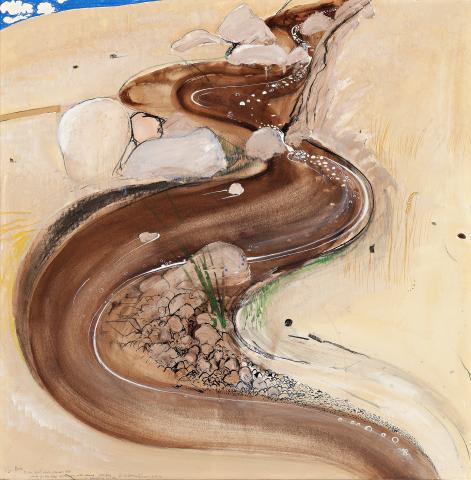2PM LIGHT EARLY JANUARY 1984, 1984
BRETT WHITELEY
mixed media on card on board
76.0 x 76.0 cm
signed, dated and inscribed lower left: 'For Bob / 2pm light early January 1984 / study for the idea of a picture with sound 'gurgles' brett whiteley 2/1/84
Private collection, acquired directly from the artist
Sotheby’s, Melbourne, 4 May 2004, lot 5
Company collection, Sydney
Private collection, Sydney
‘Of all the subjects Whiteley painted in his career, landscape gave him the greatest sense of release…’1
Awarded the prestigious Wynne Prize for Australian landscape painting in 1977, 1978 and 1984 (the same year as the present work was executed), Brett Whiteley possessed a widely acclaimed talent for capturing the natural environment. As Barry Pearce elaborates, Nature offered Whiteley both inspiration and solace: ‘…if in many of his other themes Whiteley confronted the difficult questions of his psyche, landscape provided a means of escape, an unencumbered absorption into a painless, floating world.’2
After a tumultuous decade abroad, in 1969 Whiteley returned to Australia and embarked upon an artistic pilgrimage to rediscover his homeland. Captivated afresh by the beauty, vastness and variety of the Australian landscape, he explored first the changing chromatic illusions and ‘optical ecstasy’ of Sydney Harbour’s Lavender Bay in sumptuous Matisse-like panoramas, before subsequently revisiting the landscape of his boyhood in the western New South Wales towns of Oberon, Kurrajong, Marulan, Carcoar and Bathurst. Indelibly embedded in his imagination, the gentle vales and hills of the countryside surrounding his school in Bathurst had been not only an important impetus for his precocious endeavours, but an endless source of inspiration over the intervening years. Equally influential were the compositions of Lloyd Rees which Whiteley had first admired at Macquarie Galleries one day after school – landscapes deeply poetic in their contemplation of soft curves and arabesques all rendered with impeccable tonality. As he later recalled in a letter to his artistic mentor, ‘…They contained nature and ideas, they contained naturalism but seemed also very invented, and the adventure of them was that they showed the decisions and revisions that had been made while they had been painted. I had never seen anything like that before… it set me on a path of discovery that I am still on today – namely that change of pace in a painting is where the poetry begins.’3
In a manner reminiscent of the great Impressionists before him, Whiteley now dedicated himself wholly to the landscape of the West, observing and frequently painting en plein air the myriad effects of light upon the harsh Australian bush. In his untiring efforts to depict this area in all its seasons and moods, Whiteley also recognised a tendency which he described as ‘Chinese’, with the repetition of certain motifs symbolising states of mind: the arabesques of rivers echoed the flight paths of birds, which in turn mirrored the artist’s relaxed journey through his own domain.
A romantic celebration of this region on a blazing summer afternoon, 2pm Light Early January 1984, 1984 exemplifies superbly such works – featuring the artist’s signature stream meandering through the centre of the composition, amidst a sun-parched beige ground and rounded ochre boulders punctuated with the occasional hardy perennial. In stark contrast to his more gruelling, visually demanding canvases of previous years, there is no artifice here – no anthromorphic forms or flamboyant burlesques. Rather, the work is quite simply Whiteley’s eloquent tribute to the landscape of his boyhood where his journey as an artist first began. Indeed, as Whiteley himself reflected upon these landscapes at the time, ‘…Sometimes I have to paint pictures that have an effortless naturalness, not artificial or synthetic, not manufactured – pictures that have no affectation through mental tricks, but graceful and according to nature.’4
1. Pearce, B., Brett Whiteley: Art and Life, The Art Gallery of New South Wales, Sydney, 1995, p. 196
2. Ibid.
3. Klepac, L., Lloyd Rees – Brett Whiteley: On the Road to Berry, Heide Museum of Modern Art, Melbourne, 1993, p. 7
4. McGrath, S., Brett Whiteley, Bay Books, Sydney, 1979, p. 216
VERONICA ANGELATOS
